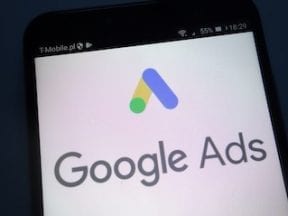Google and Microsoft advertisers have had to rethink quality copy with the format of expanded text ads and responsive search ads. But the principles of the copy are the same for all pay-per-click ads: include the searcher’s query, the product’s value propositions, and a clear call-to-action.
Standard Google ads can include at least three headlines and two description lines. Responsive search ads (“RSAs”) allow for up to 15 headlines and four description lines, from which Google (and Microsoft) tests the combinations to show ads that generate the most clicks. The challenge is that headlines and descriptions vary. The value proposition of a product or service may fit with a specific description line.
With all text ads, the third headline and second description line may not always show. Or, the description line(s) will include an ellipsis at the end, cutting a portion of the text. In the image below, both ads show just two headlines. The description for the second ad (“Patio Furniture by Outer”) is cut off.

In this example, both ads show just two headlines. The description for the second ad (“Patio Furniture by Outer”) is cut off.
Keep this in mind as you compose copy. Make sure the critical words are at the front.
Let’s review each ad component.
Headline 1
The first headline is the most critical part of your ad. It’s what users see immediately. It shapes their impressions. Headline 1 should include the searcher’s query. An ad headline in Google and Microsoft can have up to 30 characters, including spaces. If the query is shorter, include other features or a call-to-action. A search for “outdoor patio sets” may yield the following headlines.
- “Brilliant Outdoor Patio Sets”
- “Outdoor Patio Sets – 25% Off”
- “Order Your Outdoor Patio Set”
All of those headlines contain the query as well as a description, a sale, or a call-to-action.
When using RSAs, pin Headline 1 with the search query. (Headlines and descriptions in RSAs appear by default in any order. “Pinning” links headlines with specific descriptions.)
Google and Microsoft recommend that their algorithms test all combinations. However, Headline 1 is too important to leave to chance, as it informs searchers right away if your ad is relevant.
Headline 2
The first headline confirms that your ad applies to the searcher’s query. The second headline should tell searchers what to do, such as order, shop, or sign up. Include this call-to-action in Headline 2. Only the first two headlines are guaranteed to show. Thus, use Headline 2 to reassure users of the landing page and the purpose.
If Headline 1 includes the search query and the call-to-action, use Headline 2 for another value proposition, such as a sale, product benefits, or even a dynamic, personalized variable.
Pin Headline 2 if you need it to include the call-to-action. I tend to avoid pinning Headline 2, however, since Headline 1 is already pinned (and contains the search query). I’ll let the engine decide which combinations work best. Pinning the first two headlines also defeats the purpose of RSAs, which is to test many combinations. Otherwise, consider creating multiple versions of expanded text ads to test a few combinations of your choosing.
Headline 3
You should include a third headline in every responsive search ad, but the engines won’t always show it. Think of Headline 3 as a bonus message. Include another value proposition or an extra description. If it shows, great. If not, the most important messaging is in the first two headlines.
Description Line 1
Description lines can be 90 characters, including spaces. But descriptions aren’t emphasized as much as headlines and certain ad extensions.
Look at the ad below. The headlines and sitelink titles stand out because they are blue and larger.

The headlines (“Patio Pillows & Cushions…”) and sitelink titles (“Create Your Own Set” and “Find a Store Near You”) stand out because they are blue and larger.
Even with less prominence, however, make sure the description lines include the searcher’s query and relevant information, for further insight. Also, Description Line 1 should contain the most important info since Line 2 can be truncated.
Description Line 2
Description Line 2, like Headline 3, is a bonus. It won’t always show, but still include it in case it does.
RSAs can have four description lines with the option to pin any of them. But, again, my experience is not to pin anything without a strong rationale. Allow the engines to determine the best combinations of descriptions and headlines.
Display Path 1
Advertisers are allowed up to two, 15-character (includes spaces) amendments to a display URL. For example, an ad for the query “patio sets” could display www.example.com/patio-sets instead of www.example.com. The amended URL (www.example.com/patio-sets) is more descriptive and contains the searcher’s query, which will be in bold text, similar to headlines and description lines.
Display Path 2
URL paths can be increasingly granular depending on the query. A search for “outdoor patio sets” could yield an ad with www.example.com/outdoor/patio-sets.
The URL doesn’t have to be real. It will forward to the actual, designated version. Amended paths help searchers know in advance the destination page.




